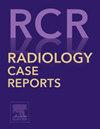Unilateral absent pulmonary artery (UAPA) with patent ductus arteriosus (PDA) in a young woman with repeated respiratory infection: A case report
Q4 Medicine
引用次数: 0
Abstract
Unilateral absent pulmonary artery (UAPA) first introduced in literatures by Oscar Fraentzel in 1898 is a rare vascular anomaly where the main pulmonary artery, rather than bifurcating, gives a solitary pulmonary artery branch to one of the lungs. The other lung, on the affected side, gets blood supply through collateral circulations, frequently through enlarged bronchial arteries. It is seen in 1 in 200,000 live births. It occurs due to the involution of the proximal sixth aortic arch on one side resulting in a unilateral absent pulmonary artery. The diagnosis can be made using contrast-enhanced CT and MRI images. Cases of UAPA can be seen in infants presenting with congestive cardiac failure and pulmonary arterial hypertension (PAH). Undiagnosed cases can result in repeated respiratory infections, complicating with bronchiectasis, pulmonary hypertension, and fibrosis gradually reducing the patient’s quality of life. In adults, the diagnosis is sometimes made with cross-sectional studies when investigating causes of repeated respiratory infection or hemoptysis. We report a case of right-side UAPA with patent ductus arteriosus (PDA) and early signs of PAH in a 24-year-old female patient with a previous history of repeated respiratory infection uncovered during contrast-enhanced chest CT imaging.
年轻女性反复呼吸道感染单侧肺动脉缺失伴动脉导管未闭1例
单侧肺动脉缺失(UAPA)由Oscar Fraentzel于1898年首次在文献中提出,是一种罕见的血管异常,肺动脉主动脉不是分叉,而是向其中一个肺提供孤立的肺动脉分支。另一个肺,在患侧,通过侧枝循环获得血液供应,经常通过扩大的支气管动脉。每20万活产婴儿中就有1人患此病。它的发生是由于一侧近端第六主动脉弓的内陷,导致单侧肺动脉缺失。诊断可通过对比增强CT和MRI图像。UAPA可以在以充血性心力衰竭和肺动脉高压(PAH)为表现的婴儿中看到。未确诊的病例可导致反复呼吸道感染,并发支气管扩张、肺动脉高压和纤维化,逐渐降低患者的生活质量。在成人中,当调查反复呼吸道感染或咯血的原因时,有时通过横断面研究做出诊断。我们报告一例右侧UAPA合并动脉导管未闭(PDA)和PAH的早期征象,患者为24岁女性,既往有反复呼吸道感染病史,在胸部增强CT扫描中发现。
本文章由计算机程序翻译,如有差异,请以英文原文为准。
求助全文
约1分钟内获得全文
求助全文
来源期刊

Radiology Case Reports
Medicine-Radiology, Nuclear Medicine and Imaging
CiteScore
1.10
自引率
0.00%
发文量
1074
审稿时长
30 days
期刊介绍:
The content of this journal is exclusively case reports that feature diagnostic imaging. Categories in which case reports can be placed include the musculoskeletal system, spine, central nervous system, head and neck, cardiovascular, chest, gastrointestinal, genitourinary, multisystem, pediatric, emergency, women''s imaging, oncologic, normal variants, medical devices, foreign bodies, interventional radiology, nuclear medicine, molecular imaging, ultrasonography, imaging artifacts, forensic, anthropological, and medical-legal. Articles must be well-documented and include a review of the appropriate literature.
 求助内容:
求助内容: 应助结果提醒方式:
应助结果提醒方式:


